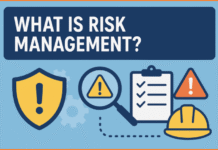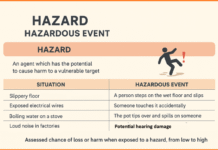Employees/workers are the major work force working under hazards. Some know the hazards and some do not. It is of great importance that they must realize that they would be the first victim of any accident, their safety awareness and all accident prevention work is in their interest and therefore their active EMPLOYEE/WORKER PARTICIPATION IN SAFETY in showing hazards and helping in removing them by the joint efforts of management and all employees is most desirable.
Section 41G of the Factories Act speaks worker’s participation in safety management. A method of safety committee is suggested. Right of workers to warm about imminent danger is also created by section 41 H and 111A of the Act.
CLICK HERE FOR ? SAFETY INDUCTION, EDUCATION, AND TRAINING
Display of the Extract of the Act and Rules (Section 108(1), Rule 106 and Form No.23) is for the same purpose of making workers aware and to call for their participation. Some areas and methods of participation are discussed below:
Areas of Participation:
EMPLOYEE PARTICIPATION IN SAFETY

General areas of participation are as under:
- To set safety goals and training programmes.
- To design and improve standard operating procedure (SOPs) and methods of operation.
- Appraisal of progress towards goals.
- To give, collect and discuss safety suggestions and to implement which are necessary. Rewards for good suggestions boost up motivation for participation.
CLICK HERE FOR ? HISTORY OF THE SAFETY
McGregor’s theory states that participation management has a basic belief in the competence and abilities of individual employees regardless their status in organisation. EMPLOYEE PARTICIPATION IN SAFETY is essential for success of any safety programme.
When workers are taken into confidence in designing any safety programme or goal they feel themselves responsible for its success. This element of involvement and joint responsibility is most fundamental to employee participation.
CLICK HERE FOR ? SAFETY COMMITTEE
Methods of Safety Participation:
Safety Committee:
Rensis Likert has described four types of management system within an organisation
- Exploitative authoritative.
- Benevolent authoritative.
- Consultative.
- Participative.
This last approach of participative concept is adopted by many countries and joint efforts of workers have resulted in reducing accident.
Statutory Provisions:
A new provision was added since 23.09.87. u/41 G of the Factory Act to set up a safety committee consisting of equal number of representatives of workers and management to promote co-operation between the workers and the management in maintaining proper safety and health at work and to review periodically the measure taken in that behalf. Therefore by addition of rules 68F&Y in the Gujarat Factories Rules, on 15-2-1995, following provisions are added regarding safety committee:
CLICK HERE FOR ? Full functions of Plant Safety Committees
Applicability:
- Factories employing workers more than 250.
- Factories carrying dangerous operations u/s 87.
- Factories listed in the First Schedule.
Formation, Tenure & Right:
- A senior official shall be the Chairman.
- A Safety Officer or Factory Medical Officer shall be the Secretary.
- A representative each from the production, maintenance and purchase departments shall be members.
- Workers representative of equal number shall be elected by the workers.
- The tenure of the committee shall be 2 years.
- At least one meeting in 3 months. Minutes shall be recorded and produced before the Factory Inspector on demand.
- The committee has right to be informed of potential hazards of work places and data on accidents and working environment. The committee shall keep the data confidential and use it solely to guide on safety measures.
Functions & duties:
- Co-operation to implement health and safety policy.
- All matters of health, safety and environment and solutions to problems in that regard.
- Creation of safety awareness amongst workers.
- To conduct educational, training and promotional activities.
- To discuss reports on safety, health and environmental surveys, safety audits, risk assessment, emergency plans and implementation of the recommendations of the reports.
- To carry out health and safety surveys and identify causes of accidents.
- To look into complaints of imminent danger and suggest corrective measures.
- To review the implementation of its own recommendations.
- To from sub-committee if necessary.

The main object of the committee is to advice to Managing Director and the Safety Board or the top executive of the company on all matters of safety and health of the workers.
CLICK HERE FOR ? HIRA AND JSA
It is not a substitute for the management. Like other committees it is an organ or part of the management function and helps the management in specific area of safety.
It is a body of safety representatives for group suggestions and decisions, co-operative safety efforts and a two-way channel of communication through which suggestions can flow from employees to management and vice versa. It does not bypass the overall management control of general supervision and communication, but it aids to it.
Its advantages are:
- Brings together varying view points, yield sounder decisions than the individual members.
- Widens interest by allowing participants of work-people in their own work.
- Allows checks and cross-checks by different opinions which are essential for safety.
Its disadvantages are:
- It causes de ay in decision till the meeting are held.
- It consume more time in meetings.
- May sometimes turn into trade union meeting if so pulled by the employees. Therefore its good control to the points is necessary.
Types of Committees may be:
- Main or Central Safety Committee.
- Plant or Shop Safety Committee.
- Technical Safety Committee.
- Special purpose Safety Committee etc.
Technical Safety Committee is useful for specialized knowledge viz, guard design, process and engineering revision, hazard and risk analysis, special investigation etc. It comprises of chief engineer safety engineer/officer, head mechanic, chief chemist and similar expert technicians.
CLICK HERE FOR ? MOCK DRILL
Special Purpose Safety Committee can b set up for specific jobs and dissolved when its purpose is accomplished. Such jobs include special accident investigation, specific problems of worker behaviour, off-the job safety, rehabilitation safety celebration or contest or award occasions etc.
For a big concern different safety committees as stated above are possible, but in a small factory a single committee can carry out all functions.
Size of Committee depends on size of establishment, quantum of unsafe conditions/acts, size and relationship of various department/units, type of business etc. Workers’ representative should not be less than that of the management.
It’s Essential Requirements are:
- Set-up should be appropriate to the work (Main Committee to include key executives).
- Members should be well-known and have respect to fellow-members.
- Members must be well aware of working conditions, work methods, practices, hazards, causes of accidents and remedial measures.
- It should be as small as possible with minimum members from the sections necessary.
Policy and Procedure:
When a committee is formed, written instruction should be issued covering
- Scope of activities.
- Extent of authorities.
- Procedure as to time/place of meeting, frequency of meeting, order of business, records to be kept and attendance requirements.
CLICK HERE FOR ? SAFE WORKING LOAD
The management should make it clear that it wants results and should give effective executive supervision over the affairs of the committee. The committee members should have firm determination to advance the cause of Safety.
Some non-statutory functions are as under:
Functions of Main/Central Safety Committee are:
- To decide safety policy and planning for purchase of equipment with in-built safety devices, relationship between departments, standards to be followed in guarding testing, designing, layout, housekeeping, material handling and placing, inspections, accident investigation and records etc.
- To plan and supervise programmes of safety propaganda, education, training and maintaining interest of employees in safety.
- To make arrangement or develop safe work practices and procedures, inspection, audit and appraisal systems and all efforts to avoid or reduce accidents. To discuss control the accident rates.
- To discuss and initiate action for correction of unsafe conditions and actions. Action plan should be drawn and suitable dates fixed for completion of each task.
- To suggest safety devices and protective equipment.
- To carry out fire drill and rehearsal of on-site emergency plan.
- To scrutinize safety suggestions received through plant safety committees and to initiate action to implement the accepted suggestions.
- To arrange safety competitions and to decide awards for encouragement.
- To improve co-operative spirit between management and employees and among various departments to promote safety.
- The safety knowledge of committee members should be increased by training lectures of safety experts of the plant and outside and by sending the members to seminars. Factories inspectors and safety specialists can be utilized for this purpose.
- To discuss and approve safety budget.
- To discuss, distribute and supervise responsibilities for quick compliance of safety remarks.
- To suggests changes in safety organization and its activities for better performance.
- To suggest safety aspects of new design and construction of plant, machinery and equipment.
- To decide disciplinary procedure and disposal of specific safety problems.
CLICK HERE FOR ? RADIATION SAFETY
People also search for:
- Why is it important for employees to be involved in the safety and health program.
- Employee participation in the safety program.
- How to get employees involved in safety.
- Workplace safety engagement ideas.
- Purpose of employee participation in safety.
- Employee participation in safety ppt.
CLICK HERE FOR ? EXCAVATION SAFETY





